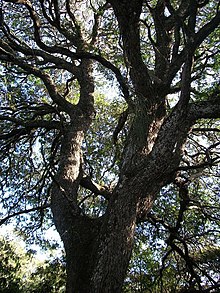Newtonia hildebrandtii, the Lebombo wattle (Afrikaans: Lebombowattel, Zulu: Umfomothi),[1] is a medium-sized tree native to eastern Africa. It is a protected tree in South Africa.[1]
| Newtonia hildebrandtii | |
|---|---|

| |
| Scientific classification | |
| Kingdom: | Plantae |
| Clade: | Tracheophytes |
| Clade: | Angiosperms |
| Clade: | Eudicots |
| Clade: | Rosids |
| Order: | Fabales |
| Family: | Fabaceae |
| Subfamily: | Caesalpinioideae |
| Clade: | Mimosoid clade |
| Genus: | Newtonia |
| Species: | N. hildebrandtii
|
| Binomial name | |
| Newtonia hildebrandtii | |
Description
editNewtonia hildebrandtii is a medium-sized tree growing to a height of about 25 m (80 ft). The trunk is usually rough, and the small branchlets and twigs are puberulous (densely covered with very short soft hairs) when young. The leaves are bi-pinnate and up to 8 cm (3 in) long, each leaf having four to seven pairs of pinnae, and each pinna having six to nineteen pairs of leaflets. There is usually a gland between each pair of pinnae. The leaflets are linear or oblong and up to 11 by 3 mm (0.43 by 0.12 in) long, with the underside often having raised lateral nerves. The inflorescence is a spike up to 8 cm (3 in) long composed of whitish or creamy flowers, which are followed by flattened pods up to 30 cm (12 in) long.[2][3]
Distribution and habitat
editThis tree is found in eastern Africa, its range extending from Kenya and Tanzania, through Malawi, Zimbabwe and Zambia, to Mozambique, Eswatini and KwaZulu-Natal in South Africa.[3] Generally a tree of riverside forests, it also grows in sandy areas with a high water table, at altitudes of up to about 1,100 m (3,600 ft);[2] these include the Southern African Sand Forest.[4]
Uses
editThe timber of Newtonia hildebrandtii is used for building construction and for making poles and implements, and for carving. The wood burns well and makes good-quality charcoal.[2] Products from the tree are also used in traditional medicine; an extract of the roots is used against worms, and an extract from the bark has been shown to have antimicrobial activity against a range of pathogens.[5]
See also
editReferences
edit- ^ a b "Protected Trees" (PDF). Department of Water Affairs and Forestry, Republic of South Africa. 3 May 2013. Archived from the original (PDF) on 5 July 2010.
- ^ a b c Louppe, Dominique (2008). Plant Resources of Tropical Africa. PROTA. p. 397. ISBN 978-90-5782-209-4.
- ^ a b "Newtonia hildebrandtii (Vatke) Torre". Plants of the World Online. Kewscience. Retrieved 22 July 2019.
- ^ Wayne Matthews. "Maputaland's Tembe Elephant National Park – a little known reserve with many natural secrets". Retrieved 15 August 2019.
- ^ Fern, Ken. "Newtonia hildebrandtii (Vatke) Torre". Tropical Plants Database. Retrieved 22 July 2019.
External links
edit- Media related to Newtonia hildebrandtii at Wikimedia Commons
- Data related to Newtonia hildebrandtii at Wikispecies